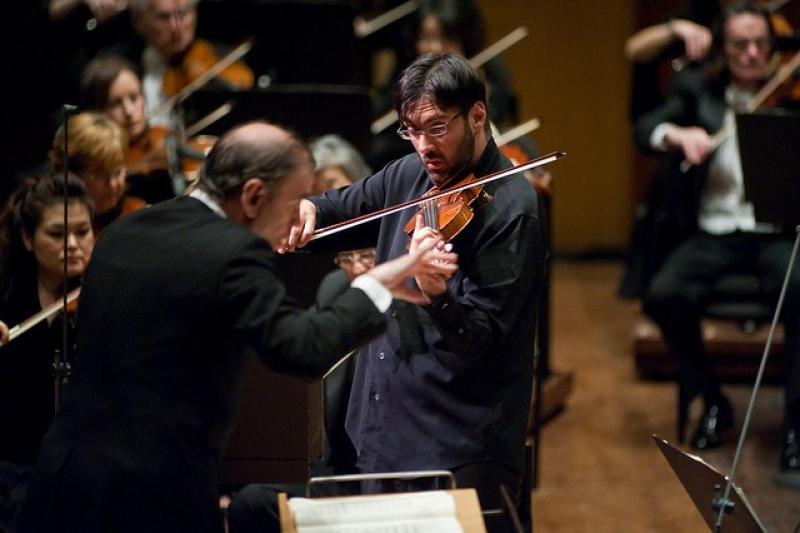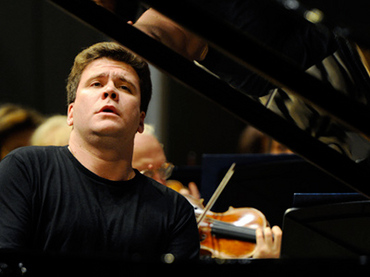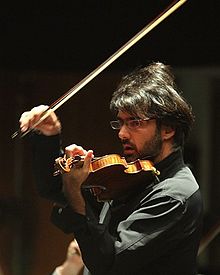Kavakos, Matsuev, London Symphony Orchestra, Gergiev, Barbican | reviews, news & interviews
Kavakos, Matsuev, London Symphony Orchestra, Gergiev, Barbican
Kavakos, Matsuev, London Symphony Orchestra, Gergiev, Barbican
Two master soloists help deliver a heavenly conclusion to Gergiev's Szymanowski cycle

Valery Gergiev’s exploration of the music of Karol Szymanowski is one of the most vitalising series mounted at the Barbican in recent years - to compare, say, with Sir Colin Davis’s Sibelius and Berlioz, Michael Tilson Thomas’s tributes to Leonard Bernstein, or Gergiev’s own Shostakovich and (increasingly) Prokofiev.
The first point, and Gergiev himself is in no doubt about this, is that Szymanowski belongs right up there with the best of them. An uncredited introductory note (the others, pithy and perceptive, are by Polish-Russian specialist Adrian Thomas) rightly points out that Szymanowski was born, in the then Polish Ukraine, during a three-year wunderkind period which also saw the births of Bartók, Stravinsky and Webern (he might have added Casella). As miraculous an era as the torch-passing year 1934 among English composers.
Bartók is especially relevant, for if one is going to compare Szymanowski’s Fourth Symphony - a piano concerto in all but name, and composed like Bartók's last (American) works to keep the Polish composer afloat during a period of financial duress and terminal health problems - to anything, it would be to Bartók's as yet uncomposed Third Piano Concerto. The sound world is similar: the pressing, bubbling woodwind sustaining long lines in eerie double octaves, especially as hauntingly delivered here by 1998 Tchaikovsky competition first-prizewinner Denis Matsuev (pictured below right); and the sudden bursts of aggressive, then flailing, energy: other-worldly, mysterious, somehow disembodied.
The Fourth Symphony acquired an audible, intricate logic and allure, and detail galore
The last three are epithets one might expect to apply to Szymanowski’s middle period - the First Violin Concerto, the Third Symphony (which Gergiev, paradoxically, rather hammered in the preceding concert) and the ravishing Songs of an Infatuated Muezzin. But that makes the point. Valid though the perception of Szymanowski’s work as falling into three periods may be (Straussian and/or Regerian, exotically Ravel-like, and finally folksy, echoing (or even preceding) Bartók and possibly akin to the Stravinsky of Les Noces or The Soldier’s Tale - there were splays of Firebird, too, in this LSO concert) the story is - as invariably with triple-period definitions of composers’ work - insufficient: the exoticism feeds into even the acerbic elements of Symphony Four and (as witnessed here, in the wonderful hands of Leonidas Kavakos, surely the best thing to emerge from Greece since Theodorakis and Themistocles) the Second Violin Concerto. To feel this most intensely, it is worth listening to Szymanowski’s late Second String Quartet.
 So why was Gergiev’s reading of these two works, with soloists one could compare to Gilels and Oistrakh, so much more compelling than the chorus-led Symphony Three? Because Valery Gergiev, keen-eyed and keen-witted, imported into both the very qualities lacking in his "Piesn o nocy" ("Song of the Night"). Conscious of his soloists, and scrupulously accompanying them as he might in a Schumann or (more relevantly) Chopin concerto, he kept the whole orchestra restrained, nervous, on tenterhooks, allowing the piano, and in the second work, violin, to glisten and gleam, beckon or bluster: so that the whole of the symphony acquired an audible, intricate logic and allure, and detail galore - fabulous flutes, superbly mellow yet insistent clarinets, amazing flickers of bassoon (can a bassoon "flicker"?), and the piano in both works - for there is one in the violin concerto too, producing extraordinary, sometimes contradictory glints in the sensual textures, while boosting the percussive bits too - was allowed to emerge.
So why was Gergiev’s reading of these two works, with soloists one could compare to Gilels and Oistrakh, so much more compelling than the chorus-led Symphony Three? Because Valery Gergiev, keen-eyed and keen-witted, imported into both the very qualities lacking in his "Piesn o nocy" ("Song of the Night"). Conscious of his soloists, and scrupulously accompanying them as he might in a Schumann or (more relevantly) Chopin concerto, he kept the whole orchestra restrained, nervous, on tenterhooks, allowing the piano, and in the second work, violin, to glisten and gleam, beckon or bluster: so that the whole of the symphony acquired an audible, intricate logic and allure, and detail galore - fabulous flutes, superbly mellow yet insistent clarinets, amazing flickers of bassoon (can a bassoon "flicker"?), and the piano in both works - for there is one in the violin concerto too, producing extraordinary, sometimes contradictory glints in the sensual textures, while boosting the percussive bits too - was allowed to emerge.
Here indeed was a comparison with Brahms, a composer Szymanowski (unlike Britten) admired, and whose influence is palpable on Szymanowski’s piano sonatas, which remind us that Szymanowski’s keyboard oeuvre defies period specification and introduces other ingredients to the heady, characterful (but absorbed, not eclectic) mix. With both composers (here it was Brahms's fourth and final symphony, a masterclass in instrumental deployment), the fascinating hinterland of external and internal detail, the phenomenal filigree of rippling woodwind, was never lost, even if the sound, albeit much less at the back than the middle of the Barbican, is still overwhelmingly immediate (give us a boomy, appetisingly reverberant cathedral anytime, or Symphony Hall’s brilliant, enabling but now underused echo chamber portals), and needlessly acidic.
Gergiev is an absolute master at connecting. Time and again, at some orchestral link passage (or even a fulcral chord) in both composers - and there were some jolly tricky ones in this concert - with or without a score, he can control a transition, with those eagle and sometime abstracted eyes, plus fluttery fingers, intriguing though often unintelligible to an audience (not, it seems, the players), driving it on or pulling it back with the merest tweak of rubato, so as to generate a rhythmic jolt, or judder, or jerk that lifts the whole thing into a different mode. This is what, above all, makes his handling so bold, nervy, electrifying, above all, enlightening. It’s what you need in Beethoven; but it is crucial with Brahms, and Szymanowski too.
It would be difficult to fault these two solo performances. Right the way from the rippling start (wonderfully reprised by Szymanowski and indeed Gergiev himself late on; the LSO strings seemed much more stylistically attuned here than in the bumptiously done Third Symphony) the magic was there, in Matsuev’s playing and the orchestral desks as well.
Gergiev and Kavakos slotting together was like a jazz session
Here was the paradox: the concertante work positively blazes in places - the biggest surges are pure Scriabin in full flow. Yet Gergiev reined it in so that one heard instrumental detail in droves. There’s a lot of it in Szymanowski, and if you miss it, he can sound like a pretty ordinary mid-European composer. Hit it, and he emerges as world-class and better. Gergiev caught it. So the blaring and tub-thumping that undermined Symphony Three was absent. Had he spoken to the orchestra, perhaps? The forces, in both works, were anyway reduced: more like a chamber orchestra, in fact - bigger for the Brahms. When Szymanowski reduces the forces to perhaps two, three, or four instruments - piano, tympani, double basses, for instance: what a moment that was - the effect is absolutely mesmerising, rather as if Shostakovich were at work. And so it was here. Thrilling, spine-tingling. Only the cadenzas (the composer’s own, presumably, for he himself was the first soloist in the work - it empowered him to earn a soloist’s healthy fee, to expend on his doomed treatment for TB at the Swiss health spa of Davos), appetisingly caressed by Matsuev, felt thinner on the ground: more than a little repetitive, material-wise.
 Even here, in Szymanowski’s penultimate work, one heard the descending ripples, or variants, or extensions, of his signal "Sabala" motif, a musical germ with chromatic potential as haunting as the Soviet’s DSCH pattern. It’s more obvious still in the Violin Concerto No 2, a very different egg from the First (which some would see as the Pole’s absolute masterpiece). Kavakos (pictured right), originally from sunny, albeit broke, Hellas, might not be a central European, but you’d think he’s been scouring the Carpathians and Tatras like Bartók, notebook in hand. Szymanowski’s folk idiom came primarily from the Tatras, which were local to his southern home in the mountain foothills, Zakopane. There he hobnobbed with folk musicians, including some very important and charismatic ones, in street, bars and drawing rooms, debriefing them of their art (which was pretty obvious to a musician of his calibre anyway). It also, surely, came from further afield (eastern Poland, for instance) as his piano music might suggest.
Even here, in Szymanowski’s penultimate work, one heard the descending ripples, or variants, or extensions, of his signal "Sabala" motif, a musical germ with chromatic potential as haunting as the Soviet’s DSCH pattern. It’s more obvious still in the Violin Concerto No 2, a very different egg from the First (which some would see as the Pole’s absolute masterpiece). Kavakos (pictured right), originally from sunny, albeit broke, Hellas, might not be a central European, but you’d think he’s been scouring the Carpathians and Tatras like Bartók, notebook in hand. Szymanowski’s folk idiom came primarily from the Tatras, which were local to his southern home in the mountain foothills, Zakopane. There he hobnobbed with folk musicians, including some very important and charismatic ones, in street, bars and drawing rooms, debriefing them of their art (which was pretty obvious to a musician of his calibre anyway). It also, surely, came from further afield (eastern Poland, for instance) as his piano music might suggest.
There’s nothing greedy, ostentatious or distracting about Kavakos’s playing. The tone is gorgeous, robust, never sickly. He and Gergiev revelled in getting things right, and the balances – more so than early in the full-orchestra Brahms, though both were pretty acceptable – were often absolutely as one could have wanted. Kavakos’s double-stopping, from the outset, was spot-on: one would have loved Bartók’s Sonata for Solo Violin as a half-an-hour encore. Cor anglais amid the textures, a muted trumpet that wafted us straight to the elusive world of Szymanowski’s exotic period, a mesmerising slow mazurka that could have been Heifetz playing gorgeous Samuel Barber, excitingly unexpected pedal points in the double basses, these were among a million glinting highlights: and we heard them all.
Szymanowski’s Zakopane is, of course, the adoptive home of Nigel Kennedy. Watching Gergiev and Kavakos (and indeed the compacted LSO) slotting together in this Barbican event, one might have been present at a jazz (in places, even jam) session. Kennedy and Grappelli, Gergiev and Kavakos. Heavenly music: but heavenly music-making too.
rating
Share this article
Add comment
The future of Arts Journalism
You can stop theartsdesk.com closing!
We urgently need financing to survive. Our fundraising drive has thus far raised £49,000 but we need to reach £100,000 or we will be forced to close. Please contribute here: https://gofund.me/c3f6033d
And if you can forward this information to anyone who might assist, we’d be grateful.

Subscribe to theartsdesk.com
Thank you for continuing to read our work on theartsdesk.com. For unlimited access to every article in its entirety, including our archive of more than 15,000 pieces, we're asking for £5 per month or £40 per year. We feel it's a very good deal, and hope you do too.
To take a subscription now simply click here.
And if you're looking for that extra gift for a friend or family member, why not treat them to a theartsdesk.com gift subscription?
more Classical music
 Bizet in 150th anniversary year: rich and rare French offerings from Palazzetto Bru Zane
Specialists in French romantic music unveil a treasure trove both live and on disc
Bizet in 150th anniversary year: rich and rare French offerings from Palazzetto Bru Zane
Specialists in French romantic music unveil a treasure trove both live and on disc
 Scottish Chamber Orchestra, Ibragimova, Queen’s Hall, Edinburgh review - rarities, novelties and drumrolls
A pity the SCO didn't pick a better showcase for a shining guest artist
Scottish Chamber Orchestra, Ibragimova, Queen’s Hall, Edinburgh review - rarities, novelties and drumrolls
A pity the SCO didn't pick a better showcase for a shining guest artist
 Kilsby, Parkes, Sinfonia of London, Wilson, Barbican review - string things zing and sing in expert hands
British masterpieces for strings plus other-worldly tenor and horn - and a muscular rarity
Kilsby, Parkes, Sinfonia of London, Wilson, Barbican review - string things zing and sing in expert hands
British masterpieces for strings plus other-worldly tenor and horn - and a muscular rarity
 From Historical to Hip-Hop, Classically Black Music Festival, Kings Place review - a cluster of impressive stars for the future
From quasi-Mozartian elegance to the gritty humour of a kitchen inspection
From Historical to Hip-Hop, Classically Black Music Festival, Kings Place review - a cluster of impressive stars for the future
From quasi-Mozartian elegance to the gritty humour of a kitchen inspection
 Shibe, LSO, Adès, Barbican review - gaudy and glorious new music alongside serene Sibelius
Adès’s passion makes persuasive case for the music he loves, both new and old
Shibe, LSO, Adès, Barbican review - gaudy and glorious new music alongside serene Sibelius
Adès’s passion makes persuasive case for the music he loves, both new and old
 Anja Mittermüller, Richard Fu, Wigmore Hall review - a glorious hall debut
The Austrian mezzo shines - at the age of 22
Anja Mittermüller, Richard Fu, Wigmore Hall review - a glorious hall debut
The Austrian mezzo shines - at the age of 22
 First Person: clarinettist Oliver Pashley on the new horizons of The Hermes Experiment's latest album
Compositions by members of this unusual quartet feature for the first time
First Person: clarinettist Oliver Pashley on the new horizons of The Hermes Experiment's latest album
Compositions by members of this unusual quartet feature for the first time
 Gesualdo Passione, Les Arts Florissants, Amala Dior Company, Barbican review - inspired collaboration excavates the music's humanity
At times it was like watching an anarchic religious procession
Gesualdo Passione, Les Arts Florissants, Amala Dior Company, Barbican review - inspired collaboration excavates the music's humanity
At times it was like watching an anarchic religious procession
 Classical CDs: Camels, concrete and cabaret
An influential American composer's 90th birthday box, plus British piano concertos and a father-and-son duo
Classical CDs: Camels, concrete and cabaret
An influential American composer's 90th birthday box, plus British piano concertos and a father-and-son duo
 Cockerham, Manchester Camerata, Sheen, Martin Harris Centre, Manchester review - re-enacting the dawn of modernism
Two UK premieres added to three miniatures from a seminal event of January 1914
Cockerham, Manchester Camerata, Sheen, Martin Harris Centre, Manchester review - re-enacting the dawn of modernism
Two UK premieres added to three miniatures from a seminal event of January 1914
 Kempf, Brno Philharmonic, Davies, Bridgewater Hall, Manchester review - European tradition meets American jazz
Bouncing Czechs enjoy their Gershwin and Brubeck alongside Janáček and Dvořák
Kempf, Brno Philharmonic, Davies, Bridgewater Hall, Manchester review - European tradition meets American jazz
Bouncing Czechs enjoy their Gershwin and Brubeck alongside Janáček and Dvořák
 Solomon, OAE, Butt, QEH review - daft Biblical whitewashing with great choruses
Even a top soprano and mezzo can’t make this Handel paean wholly convincing
Solomon, OAE, Butt, QEH review - daft Biblical whitewashing with great choruses
Even a top soprano and mezzo can’t make this Handel paean wholly convincing

Comments
What a bizarre rift between